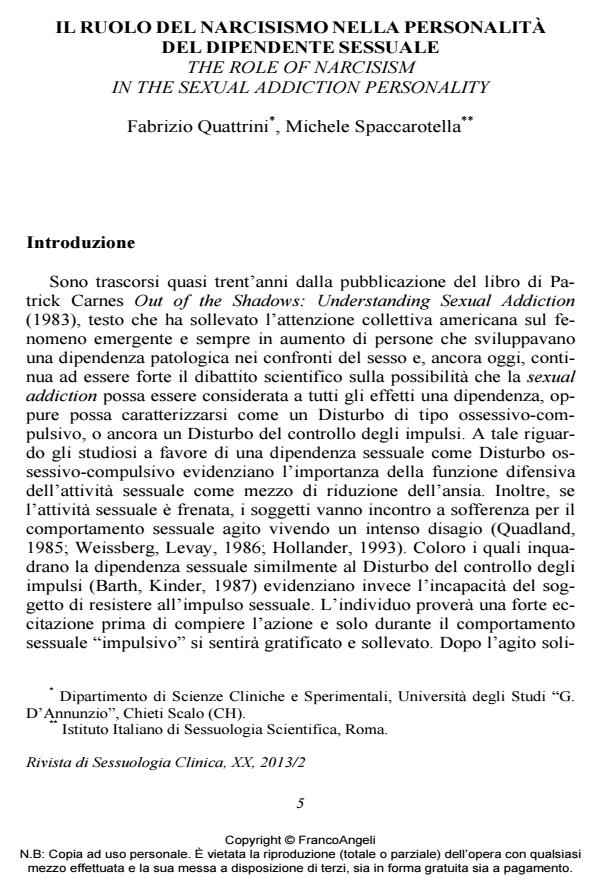Il ruolo del narcisismo nella personalità del dipendente sessuale the role of narcisism
Titolo Rivista RIVISTA DI SESSUOLOGIA CLINICA
Autori/Curatori Fabrizio Quattrini, Michele Spaccarotella
Anno di pubblicazione 2013 Fascicolo 2013/2
Lingua Italiano Numero pagine 31 P. 5-35 Dimensione file 417 KB
DOI 10.3280/RSC2013-002001
Il DOI è il codice a barre della proprietà intellettuale: per saperne di più
clicca qui
Qui sotto puoi vedere in anteprima la prima pagina di questo articolo.
Se questo articolo ti interessa, lo puoi acquistare (e scaricare in formato pdf) seguendo le facili indicazioni per acquistare il download credit. Acquista Download Credits per scaricare questo Articolo in formato PDF

FrancoAngeli è membro della Publishers International Linking Association, Inc (PILA)associazione indipendente e non profit per facilitare (attraverso i servizi tecnologici implementati da CrossRef.org) l’accesso degli studiosi ai contenuti digitali nelle pubblicazioni professionali e scientifiche
La "sexual addiction" rappresenta ancora oggi un aspetto disfunzionale del comportamento sessuale dell’individuo che difficilmente trova una collocazione clinica, psicopatologica e diagnostica chiara ed esauriente. L’utilizzo di un modello integrato fornisce la possibilità di considerare questa condizione come il punto d’incontro tra una condotta di allontanamento di sentimenti spiacevoli (caratteristica della compulsione) ed una di ricerca attiva del piacere (peculiarità dell’impulso). La personalità del sexual addicted risulta caratterizzata da un particolare atteggiamento sessuale che investe tutte le sue relazioni. Relazioni che non possono essere considerate tali, in quanto il soggetto utilizza il sesso solo come una conferma della propria importanza/esistenza. Come accade nel narcisismo, la persona ha bisogno degli altri per mantenere coeso il proprio equilibrio interno, ma allo stesso tempo li deve allontanare poiché li ritiene un pericolo per la propria incolumità psichica. L’incapacità del dipendente sessuale di entrare in un reale contatto con l’altro, estremizzando il proprio comportamento sessuale, ha spinto gli Autori ad avanzare l’ipotesi di una possibile correlazione tra le caratteristiche del dipendente sessuale e quelle della personalità narcisistica.
Parole chiave:Dipendente sessuale, personalità narcisistica, sexual addiction, compulsione, impulso sessuale, porno-dipendenza.
Fabrizio Quattrini, Michele Spaccarotella, Il ruolo del narcisismo nella personalità del dipendente sessuale the role of narcisism in "RIVISTA DI SESSUOLOGIA CLINICA" 2/2013, pp 5-35, DOI: 10.3280/RSC2013-002001